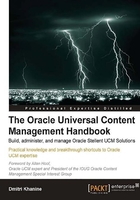
What this book covers
In this section I'll quickly guide you through the chapters of the book itself, and show you what each of them will help you achieve.
Chapter 1, Getting Up and Running, is a deluxe walkthrough that takes you over building your personal "sandbox", downloading free unlimited evaluation software, and completing the installation. It also "shows you around the house" to get you instantly familiar with core UCM Document Management.
Chapter 2, Major Controls, guides you through all major controls of Content Server in time it takes to have lunch. Get instantly familiar with operations, diagnostics, and troubleshooting, and also learn how to manager users.
Chapter 3, Metadata, helps you master standard and custom metadata, and learn how to quickly perform complex customizations on Check In, Content Info, and Search screens without a single line of code.
Chapter 4, Understanding Security, gets you a crystal clear understanding of UCM Security Model and how to get it right, the first time around, to avoid costly redesigns.
Chapter 5, Understanding Workflows, explains what UCM workflows can do for you and how to use them. It includes tutorial for advanced workflow design that shows you how to use jumps, sub-workflows, basic and criteria workflows, tokens, and aliases.
Chapter 6, Understanding Virtual Folders and WebDAV, tells you all about Virtual Folders. It is a detailed walkthrough that shows how to set up and use folder structures, so you can bring alive your shared drives and other existing content.
Chapter 7, Under the hood, is an in depth review of the file system, content store, and important utilities (for managing System Configuration and Process Administration), also discover how Content Server is designed to be so lightning-fast.
Chapter 8, Backup, Restore, and Content Migration, shows you how to backup and restore the Content Server like a pro — to avoid devastating data losses. Also learn to use Archiver — to remove inactive content, migrate items to other servers, and mass-update metadata. (This tip alone can white-out days of mind-numbing manual labor from your life's chart).
Chapter 9, Migrating Configuration, shows you how to transfer just the changes you want from Development to Testing and Production environments. Avoid the quicksand of manually applying the same changes to multiple environments.
Chapter 10, Customizing Oracle UCM, introduces you to all the tools and techniques available for altering UCM interface and behavior. It also shows you how to smoothly integrate into your overall organization's infrastructure and avoid dreaded manual data re-entry and multiple "source of truth" repositories that spell disaster for content management systems.
Chapter 11, Web Content Management and Collaboration, is your complete step by step walkthrough of creating killer websites with Site Studio Designer. It walks you through the server-site set up, and how to best use templates, regions, and fragments.
Appendix A, Exploring Oracle UCM Product Offering, gives you an in-depth review of the entire Oracle UCM Product Offering, insider tips, strongest sides, and the caveats you need to be aware of — when using dozens of products and components within the UCM Suite (and how to avoid missing the cut by picking a wrong tool for the job).
Appendix B, Detailed Oracle UCM Resource Directory, is your instant access to many valuable print and online resources, trusted system integrators, UCM training providers and more. Here're just a few categories of resources you will find in Appendix B:
- Free online resources — a comprehensive listing of UCM-specific and general content-management related blogs, review, and article sites. Many of these hidden gems are not actively promoted and you won't pick them up from a Google search.
- Best recommended publications — the few UCM-related books and whitepapers you may find really useful some even indispensable.
- Trusted System Integrators — a small list of time-tested, good track record Oracle Partners that specialize in the UCM space.
- Trusted Training Providers — just like the System Integrators, this is a small list of vendors you can start with if you're looking for official or customized Oracle UCM training.
- Value-Added Products and Services — a list of products that may help you avoid expensive customizations or save you time on content migration and other time consuming initiatives.
Be sure to check your Resource Directory when you are done reading the chapters.
And now let's see what kind of hardware and software you will need to run the examples and follow the tutorials from this book.